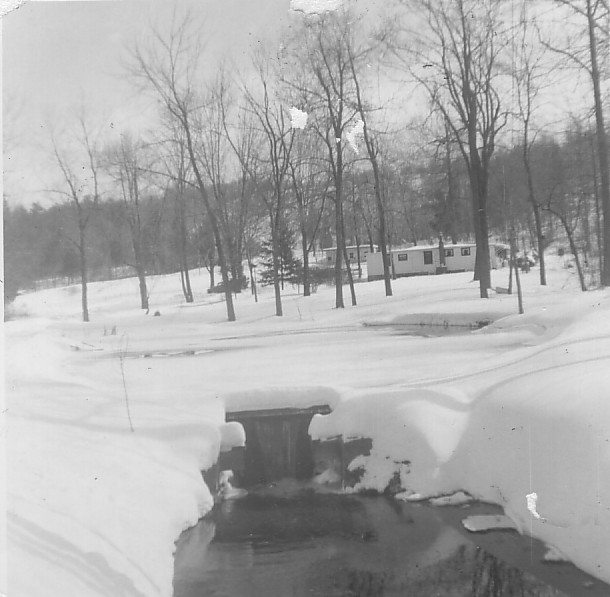
pic#1
Our old home on what the Boro referred to as Nielsen Avenue which in fact was a dirt road we called Spear Lane. The “proposed” Avenue was to connect Long Hill road to Grove Street for a main entry to develop the entire area. It was particularly a “sore spot” one day to us when a Survey crew hired by the Boro came through without asking permission and staked out a broad “right of way” right across our property, across our pond, up our driveway and down across our field, pounding rib boned survey stakes in the ground! We quickly went behind them and tore up their survey stakes and through them in the burn barrel! The proposed “avenue” never was completed nor ever any work done on it and our old Spear Lane road out to Long Hill was only casually ever plowed by a Town truck of snow in the winter. We basically always maintained the road with our own labors, which always was fine with us!
The pond was our pride and joy, a long time before it had been a lot larger one that provided water for great grandfathers sawmills. This was the stream that originated at the “big Spring” farther up in the woods; the “Martin” or “Vernam” Spring where there had been a bottling company, Trout raising ponds and in the 1950’s a goldfish hatchery.
Not seen in the picture was a metal “paddle-wheel” my father had made from an old metal wheelbarrow wheel. He positioned it on the dam spillway and it was always a mesmerizing past time to watch it spin around in the falling water. In times of heaver rains, the stream run off would be more than the dam or the road pipe could contain, and it often backed up and several times completely washed out the road at the crossing point. We would haul load after load of sand, hand filled in our old home-made dump truck to fill it back in, and using our home-made snow plow would push it around until it was again filled in. The sandbar created by the incoming stream’s flow was always a near constant project to dig out, it was very labor intensive and twice my father, brother and I used a hand scraper drag, connected with pulleys and snatch blocks to dig the pond out of mud. Never having the use of power equipment, this was a very intensive amount of work and we eventually filled in an area of boggy land beyond the pond with the scrapings, eventually turning it into a lawn.* The richness of the excavated material made the grass there grow like crazy and every 3 or 4 days or so had to be cut. I later used that area to grow rhododendrons which thrived in the moist ground.
Seen in the picture is our little house that my father had built “from anything he could carry home” started during the Depression years of the 1930’s it was home to our family for many years. Beyond that farther up the hill was a house built by my grandfather Andrew I Spear, that had been on the location of an even earlier house. Its where my grandfather spent his last years. The roof was held up by narrow gage railroad rails, salvaged from the original 1869 railroad that came through Oakland!
Beyond the Upper house, (that of Andrew Spear) can be seen through the trees the rise of ground and the “sandpit” that had been started in the 1920’s as a burrow pit for sand fill. The old Dodge trucks used in the operation were housed in the garage under the Sawmill and a gas shovel in the pit used to load them. My father once said that the sand was of such purity there, it was trucked to the site of George Washington bridge across Hudson River in the 1930’s. Indeed the sand was of such a fine consistency, it was referred to as “dead sand” free of any large stones and of a fine grained quality it required no sieving to extract unwanted larger particles which was much valued for mixing concrete. To the consistency of “mortar cement” it was highly prized.
This unique geological feature of these layered belts of different subsoil’s always intrigued me as it still does. It seems at one time they had been laid down by an ancient prehistoric seafloor that covered this entire region. It’s value was realized years later by contractors who carted away some 1.3 million cubic yards of fill from the surrounding hill. As it was later proved, it had exceeded the original soil mining permit by nearly a million cubic yards! but apparently, curiously, the obvious infraction “melted away” one can only speculate as the result of pay-offs or political contributions made the infraction “go-away”
Onto the “sand-hill” had once stood a stand of tall red pines, one of the few remaining native conifers in the area. The tall trees, waved in the wind which roared through their tops like the sound of a “Niagara of wind” As a kid I enjoyed going up there and sitting under the trees and listening to their wild song. Too bad as they fell victim also to the excavation work later on. Another group of these tall red pines were in a small grove along the edges of what had been the old Spear back fields. Trailing “ground-pine” there, a type of ancient “lichen-like evergreen fern” and pine boughs were harvested to make Christmas wreaths and sprays for our front door during the Holidays.
To the left of center of the picture can bee seen a slightly sloping “bare area” covered here in snow. This had been a tiny burrow pit also of sand. We eventually had it graded off to fill in the old holes and years afterward, I built a one-car garage there and had an extensive rock-garden. I had with great ingenuity laid a one –inch plastic pipe all the way from the big Spring to this rock garden and utilizing my family –inherited talents I guess from John and Jacob Speer, dug out a couple of shallow ponds there, lined with plastic to prevent the water from draining away and had water cress and all manner of plants there. Even a tiny muskrat took up his home in the one small impoundment and became so friendly I could pet him on the head while he chomped away on a tasty water tuber plant! It was my little slice of Eden there I guess and I took a lot of pride in it. The plastic water line I had sprinklers connected on it to provide water for everything and even had a working toilet and sink in the garage using the gravity power to operate it! What remained of the overflow (which was very little) fettered away via a drain pipe off to the side. One year I recall planting wave after row of “balcony petunia’s” on the slope and they thrived, taking over the entire hillside in a blaze of blue, purple, red, and white blossoms. I even had “sun-dew” plants I brought home from Sunday morning hikes in the Newark watershed and they also grew in my small “wetlands” I had built!
Three tiny “false blue “cypress trees I purchased from Glenwild garden center in 2 gallon containers, when last seen were over 15 foot tall!
It always seemed as though winter snow storms were particularly tough here, because of the remoteness of the property and the fact we were responsible for keeping it plowed to Long Hill road using our home-made equipment. My father had built a home-made dump truck from an old 1929 Pierce-Arrow touring car. Curiously he had removed the huge straight 8 cylinder engine during World War 2 due to the gas rationing in force and put in it’s place a heavy 4 cylinder model A Ford engine ! I often wondered why he hadn’t just kept the Model A Ford instead?…but my Dad always had a reason for doing things! He built a heavy blunt faced snow plow, made of 8X8’s and faced with 2 X12’s which he then sheathed in aluminum so the snow would slide off. Skids on the bottom acted as “shoes” and the entire thing was attached using chains to the frame of the car! It was a monster of a home-made plow and it utilized brute strength and smashing power to bulldoze its way through snow drifts! A set of tire chains on the old rear wheels and a load of sand in the home-made wood dump body provided traction. I remember one time when finally the old bald tires let go with a loud near “shotgun blast” as they blew apart!. After that, two old Lincoln wheels and tires, provided by our neighbor, Ray Dougherty sufficed after some jury-rigged lug bolts to hold them fast! That old truck kept us “plowed out” many a winter, and the dump body was used year round for carting. I learned how to drive on that old 1929 Pierce-Arrow jalopy!
Nearly all the trees on the property
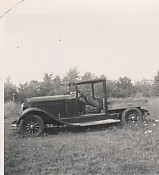
pic#2
were swamp maples or Silver maples.
There were two large sugar maples in
the property corner that had been
tapped at one time to collect the sap for
“sugaring” There were also oaks and
shag bark hickory, ironwood, and along
the stream were “silver and yellow”
Birch. “Acorn oaks” were prized by
many gray squirrels, rabbits and
raccoons, possums, skunks, both red
and gray foxes and turtles in the water courses, and herons would stand along the shoreline to catch frogs and bugs. On hot June and July evenings, lightening bugs would spark and glow all over and in the hot summer, the rasping sound of cicadas filled the air. It was a great place to grow up as a kid, I was forever immersed up to my elbows in the brooks and cold water that would have me in perpetual “sniffles” and “chills” and worry my mother incessantly!
In the mud I would uncover weird looking crayfish. These tiny cousins of the salt water varieties and distant cousins of scorpions were common, along with bright orange salamanders that were toxic and of course, long water snakes that twined among the elderberry bushes. “King fishers” were considered to be air pirates as they would perch on the electric line that ran along the shoreline and watch for a trout dinner in the inlet stream. The wily fish knew to position themselves there to catch food parcels washing in from the brook. In later years I would make a trip out to Saylorsburg, Pennsylvania and bring back brown trout fingerlings to stock the pond. They did well and grew to a good size, although I could never bring myself to catch them for dinner- they became pets instead!
Large Blue Heron would stand on one stilted leg in the brook also to fish in the mornings as ground fog slowly lifted revealing his watery world around him.
Toward the right of the picture and out of sight in the border of the woods was a huge ancient rock. Dark with age, it bore creases and scrapings from the Ice Age, 18,000 years ago. It was “my time capsule” I recall- I often mused “if only this old rock could talk! what a fantastic tale it could tell of all those intervening centuries.” I envisioned the land as it must have been, then, with great tall evergreen pines and herds of grazing elk and even before that perhaps a plodding wooly mammoth or mastodon? or a Saber-tooth lion!
Then, native Indians nearby perhaps with a bark long house and their cooking fires and the first white explorers and Dutch settlers who came to these parts over four hundred years ago. That old rock, perhaps not much to look at was like a “key” opening history’s ancient door, a solid, immovable object of stone that had been lodged there who knows how many millennium before?
The surrounding woods, once having belonged to our family since perhaps the early 1800’s had provided lumber for houses, stone for foundations, sand for fill and mortar, boughs for Christmas decorations and an environment we called “Home” for many years.
The “home-made” house wasn’t perhaps as impressive as other contractor built places but it served our family well for many years.
recollections of Bob Spear; August 2013 “growing up in old Oakland”
*photo: “Home” Winter scene, early 1960’s pic#1
Pic#2 page 3 ; The venerable old 1929 Pierce Arrow that had been made into a dump truck-aka “all around use” This old truck also served to cart us kids around for some “hair-raising rides” driven by dad around the woods roads!. Once when the restraining chain broke- dumping the three of us off in mid-ride! Using our combined weight for wheel traction at times was the method for climbing some steep hills! The little 4 cylinder Ford engine looked out-of-place in the large touring car chassis but it served us well for many years.
Parking it on a hill to “jump-start” it was the preferred method for starting! as the old electric system, dating some thirty-one years was unreliable to churn the ancient 6 volt starting motor. The “clanky” old engine however, only about 30 horsepower was incredibly powerful for it’s size because of it’s “long stroke” torque, characteristic of Model A Ford engines. It was nearly impossible to keep a Muffler on it and often as not the
hot exhaust came directly off the exhaust manifold of the engine and blasted straight down, glowing at times a “cherry red”. Mechanical front wheel brakes was all that was left to stop it and wooden spoke wheels with heavy leaf type springs and oil shock absorbers and a steel frame like a 3 ton truck made it a real work-horse!
My friends, Tony Fowler, Charlie Vander Bush, Ron Wiker, and many others learned to drive on this beast!
“Charlie” had a 1941 Dodge pickup we used also to crash through the woods in also! The old rear gas tank finally became “obsolete” (to use a fine terminology) after tree stumps bashed it in! Then a small 3 gallon aluminum round tank was fashioned to the front that worked quite well. Prior to this Model, my father had had an even larger Seven passenger Pierce Arrow car which was long gone by the time I was older.
The tiny wood “dump box” on the rear held about a yard of sand, any more than that and the ancient rear springs would nearly cantilever backwards but it did make the “battleship-like” manual steering lighter to handle!- however one heavy load proved too much and exploded the ancient bald rear tires one day and blew them to smither-reens! It was after that, Mr Dougherty provided two huge Lincoln tires that with some “re-engineering” worked quite well.
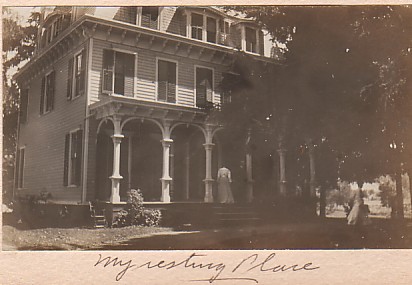
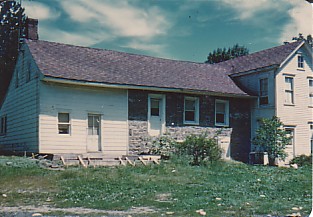
Pic#3 The “Homestead farm” on the Valley road & pic #4 (above) “My resting place” the later D.C.Bush home
The farm house above probably the stone section built in or before Revolutionary War days had been bought by
Henry I. Spear in 1828; it included a 65 or more acre group of fields for planting, a 55 acre pasture and wood lot
where he eventually constructed a sawmill, another 65 acre pasture lot to the west of Pond Hill road (long hill road),
and another 25 or so acres called “The Sandy lot” opposite the farm which included Ponds Cemetery, it’s property
line being in the middle of the Ramapo River to the west. Through the years, numerous other tracts were bought
and sold by recorded deeds. The property passed from Henry I Speer to his two sons, John H. and Jacob H. and in
turn John H’s son David H Spear Sr. inherited his portion which included the Valley road homestead farm house.
It then passed by will 2/3rds to son Andrew I Spear and 1/3rd to Anna, his daughter. Andrew inherited the saw mill,
barns, and planting fields and as a wedding gift to his sister Anna in 1900 he signed David H’s Victorian style house
and the adjoining barn and an undetermined amount of acreage. Anna’s husband David C. Bush, upon his death passed
it to his Bush family and it left the Spear hands at that point.
During the Civil War, the stone portion and the west addition were known as “the Green Cottage” tavern or in local terms as “Hank Speer’s tavern”. It was a Stage stop on the Paterson route as well, and on Catherine (Winters) Speer’s death, she willed the present lots known to Ponds Church. The more eastern double floor addition is unknown when it was added but was there in 1917 as evidenced by an early family photograph taken. In addition, there were several large barns which burned in a terrible fire between 1908 and 1915 period, destroying them completely. “There was a large fire place I recall with a huge wood mantle” ..(Lyda Spear). Nearby the house were remaining several pear trees and peach trees that still bore fruit as late as the 1950’s. (Bob Spear) In later years the house had been owned by the Hadinger family and was located approximately where the entrance way to Dairy Queen and whatever other building is there now.
My Resting place The home of Anna F. Spear and D.C. Bush was a large three story affair with ornate “ginger-bread’ moldings and cornices most likely built by Cornelius Bush of Crystal Lake who was an expert carpenter and builder.
The kitchen was in the rear with it’s own entrance and the large barn behind that that had been built by David H. Spear Sr.
The front of the house was shaded by large maple and oak trees and faced the Valley Road that was paved by 1920. A circular drive and entry road to the rear barn where carriages could be brought up to the set of stairs to the front porch.
Across the road was the Garrison home that became Aspenwood Tourists, an early day bed & breakfast for travelers. For a time, Mrs. Bush (Anna F Spear) also used extra rooms in her large house for travelling tourists and it may have sometimes been referred to as a “hotel” although in our youth, we had never heard that story. Much, much later, the home was sold and eventually became the “Jewish Community Center” of Oakland, a name many people have known it as- however, it’s history is much older than that.
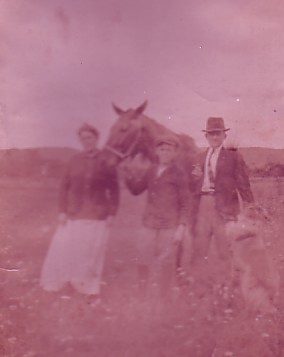
below:(pic#5) a poignant discolored antique picture (photographer unknown( of
Andrew I Spear, his wife the former Lyda Elizabeth (Bush) and young son David H.
Spear and their collie dog along the back field near their home off the Valley
Road (the old Henry I. Spear farmstead) Taken sometime between 1915 and 1917
in the World War One years. The collie was an “Albert Payson Terhune” Collie
a who wrote many books such as “Lad of SunnyBank” Mr Terhune came from
early “Dutch stock” like others in the area, and aside from being family related
was also a good friend of the family. Young David H. Spear grew up in the woods
and fields of his old home-town of Oakland which had become incorporated in
1904, the same year of his birth. He became an active member of the Boro Fire
Department under Chief Henry Hopper,and the Police Department under Chief
John Johnson, John Pauls, and Lester Merrian. He attended the Sweeny Auto-
motive and Electrical School in Kansas City Kansas in 1926-1927, helped fly the
U.S. Mail routes while there, and self-taught himself (by trial and error!) how to fly in World War One airplanes. Returning home after finishing his classes and marrying Nellie Edith Featherman in 1936 they remained in Oakland and raised their family on part of the old Speer property off Long Hill Road. During the tumultuous era of the 1920’s, the area around was a “haven” at times for mobsters from New York City and a training summer camp for no less a figure than Joe Lewis and other early boxing greats. Some “tense times” of upholding the law in those days were recalled many years later in “around the dinner table” story-hour at home.

Pic #6 “Bear Swamp Special” ! was a contraption built from
a Ford Motel T chassis and raised springs for ground clearance.
It was a later model apparently having “pneumatic balloon tires”
and some sort of “box bed” in the rear. Motel T’s were noted
for going “darn near anywhere!”. My father had many fond
memories of his “mountain roadster” as he called it.
The photo is believe to have been actually taken at Bear Swamp
in the Ramapo Mountains of Mahwah and probably in the very
early 1920’s. Unknown whatever became of the Bear Swamp
Special.
Pic #7 Ponds Church circa 1878 (the picture is reversed) Valley
Road on the left visible as a dirt lane should be on the right of
the picture. Looking north on the Valley road can be seen the
farm of Henry Speer. The Church, built in the Dutch style, very
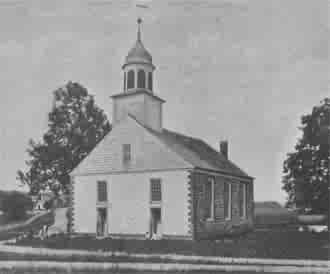
simple yet sturdy construction having two doors. (one for men
and one for women!) was faced on the east side with stone and
had a belfry with a weather vane. Stained glass windows were
added in the 1880’s. Situated at the junction of the Valley
Road and the Paterson (or Slooterdam road)[Long Hill Road]
sometimes also referred to as the “Road to Preakness” the church
had been built in 1828, finally replacing the ancient 1740 stone
hexagonal house of worship across the road and an even earlier
1710 log cabin church called “Church de’ Nor’” by the Dutch.
It survived until 1935 when it was razed and a small “Chapel” built
closer to what became the “town center”. The Oakland Library,
former “Community building” was built to replicate it. When later
renovated in the 1880’s the double doors were dispensed with and
a single entry door replaced the old Dutch style.
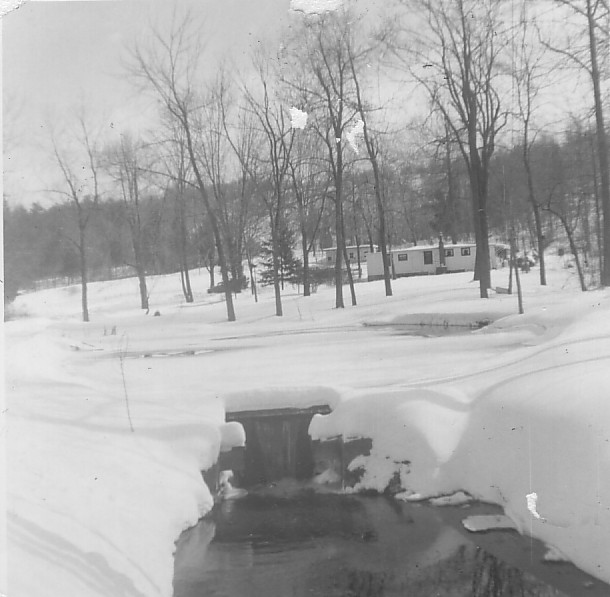
pic#1
Our old home on what the Boro referred to as Nielsen Avenue which in fact was a dirt road we called Spear Lane. The “proposed” Avenue was to connect Long Hill road to Grove Street for a main entry to develop the entire area. It was particularly a “sore spot” one day to us when a Survey crew hired by the Boro came through without asking permission and staked out a broad “right of way” right across our property, across our pond, up our driveway and down across our field, pounding rib boned survey stakes in the ground! We quickly went behind them and tore up their survey stakes and through them in the burn barrel! The proposed “avenue” never was completed nor ever any work done on it and our old Spear Lane road out to Long Hill was only casually ever plowed by a Town truck of snow in the winter. We basically always maintained the road with our own labors, which always was fine with us!
The pond was our pride and joy, a long time before it had been a lot larger one that provided water for great grandfathers sawmills. This was the stream that originated at the “big Spring” farther up in the woods; the “Martin” or “Vernam” Spring where there had been a bottling company, Trout raising ponds and in the 1950’s a goldfish hatchery.
Not seen in the picture was a metal “paddle-wheel” my father had made from an old metal wheelbarrow wheel. He positioned it on the dam spillway and it was always a mesmerizing past time to watch it spin around in the falling water. In times of heaver rains, the stream run off would be more than the dam or the road pipe could contain, and it often backed up and several times completely washed out the road at the crossing point. We would haul load after load of sand, hand filled in our old home-made dump truck to fill it back in, and using our home-made snow plow would push it around until it was again filled in. The sandbar created by the incoming stream’s flow was always a near constant project to dig out, it was very labor intensive and twice my father, brother and I used a hand scraper drag, connected with pulleys and snatch blocks to dig the pond out of mud. Never having the use of power equipment, this was a very intensive amount of work and we eventually filled in an area of boggy land beyond the pond with the scrapings, eventually turning it into a lawn.* The richness of the excavated material made the grass there grow like crazy and every 3 or 4 days or so had to be cut. I later used that area to grow rhododendrons which thrived in the moist ground.
Seen in the picture is our little house that my father had built “from anything he could carry home” started during the Depression years of the 1930’s it was home to our family for many years. Beyond that farther up the hill was a house built by my grandfather Andrew I Spear, that had been on the location of an even earlier house. Its where my grandfather spent his last years. The roof was held up by narrow gage railroad rails, salvaged from the original 1869 railroad that came through Oakland!
Beyond the Upper house, (that of Andrew Spear) can be seen through the trees the rise of ground and the “sandpit” that had been started in the 1920’s as a burrow pit for sand fill. The old Dodge trucks used in the operation were housed in the garage under the Sawmill and a gas shovel in the pit used to load them. My father once said that the sand was of such purity there, it was trucked to the site of George Washington bridge across Hudson River in the 1930’s. Indeed the sand was of such a fine consistency, it was referred to as “dead sand” free of any large stones and of a fine grained quality it required no sieving to extract unwanted larger particles which was much valued for mixing concrete. To the consistency of “mortar cement” it was highly prized.
This unique geological feature of these layered belts of different subsoil’s always intrigued me as it still does. It seems at one time they had been laid down by an ancient prehistoric seafloor that covered this entire region. It’s value was realized years later by contractors who carted away some 1.3 million cubic yards of fill from the surrounding hill. As it was later proved, it had exceeded the original soil mining permit by nearly a million cubic yards! but apparently, curiously, the obvious infraction “melted away” one can only speculate as the result of pay-offs or political contributions made the infraction “go-away”
Onto the “sand-hill” had once stood a stand of tall red pines, one of the few remaining native conifers in the area. The tall trees, waved in the wind which roared through their tops like the sound of a “Niagara of wind” As a kid I enjoyed going up there and sitting under the trees and listening to their wild song. Too bad as they fell victim also to the excavation work later on. Another group of these tall red pines were in a small grove along the edges of what had been the old Spear back fields. Trailing “ground-pine” there, a type of ancient “lichen-like evergreen fern” and pine boughs were harvested to make Christmas wreaths and sprays for our front door during the Holidays.
To the left of center of the picture can bee seen a slightly sloping “bare area” covered here in snow. This had been a tiny burrow pit also of sand. We eventually had it graded off to fill in the old holes and years afterward, I built a one-car garage there and had an extensive rock-garden. I had with great ingenuity laid a one –inch plastic pipe all the way from the big Spring to this rock garden and utilizing my family –inherited talents I guess from John and Jacob Speer, dug out a couple of shallow ponds there, lined with plastic to prevent the water from draining away and had water cress and all manner of plants there. Even a tiny muskrat took up his home in the one small impoundment and became so friendly I could pet him on the head while he chomped away on a tasty water tuber plant! It was my little slice of Eden there I guess and I took a lot of pride in it. The plastic water line I had sprinklers connected on it to provide water for everything and even had a working toilet and sink in the garage using the gravity power to operate it! What remained of the overflow (which was very little) fettered away via a drain pipe off to the side. One year I recall planting wave after row of “balcony petunia’s” on the slope and they thrived, taking over the entire hillside in a blaze of blue, purple, red, and white blossoms. I even had “sun-dew” plants I brought home from Sunday morning hikes in the Newark watershed and they also grew in my small “wetlands” I had built!
Three tiny “false blue “cypress trees I purchased from Glenwild garden center in 2 gallon containers, when last seen were over 15 foot tall!
It always seemed as though winter snow storms were particularly tough here, because of the remoteness of the property and the fact we were responsible for keeping it plowed to Long Hill road using our home-made equipment. My father had built a home-made dump truck from an old 1929 Pierce-Arrow touring car. Curiously he had removed the huge straight 8 cylinder engine during World War 2 due to the gas rationing in force and put in it’s place a heavy 4 cylinder model A Ford engine ! I often wondered why he hadn’t just kept the Model A Ford instead?…but my Dad always had a reason for doing things! He built a heavy blunt faced snow plow, made of 8X8’s and faced with 2 X12’s which he then sheathed in aluminum so the snow would slide off. Skids on the bottom acted as “shoes” and the entire thing was attached using chains to the frame of the car! It was a monster of a home-made plow and it utilized brute strength and smashing power to bulldoze its way through snow drifts! A set of tire chains on the old rear wheels and a load of sand in the home-made wood dump body provided traction. I remember one time when finally the old bald tires let go with a loud near “shotgun blast” as they blew apart!. After that, two old Lincoln wheels and tires, provided by our neighbor, Ray Dougherty sufficed after some jury-rigged lug bolts to hold them fast! That old truck kept us “plowed out” many a winter, and the dump body was used year round for carting. I learned how to drive on that old 1929 Pierce-Arrow jalopy!
Nearly all the trees on the property

pic#2
were swamp maples or Silver maples.
There were two large sugar maples in
the property corner that had been
tapped at one time to collect the sap for
“sugaring” There were also oaks and
shag bark hickory, ironwood, and along
the stream were “silver and yellow”
Birch. “Acorn oaks” were prized by
many gray squirrels, rabbits and
raccoons, possums, skunks, both red
and gray foxes and turtles in the water courses, and herons would stand along the shoreline to catch frogs and bugs. On hot June and July evenings, lightening bugs would spark and glow all over and in the hot summer, the rasping sound of cicadas filled the air. It was a great place to grow up as a kid, I was forever immersed up to my elbows in the brooks and cold water that would have me in perpetual “sniffles” and “chills” and worry my mother incessantly!
In the mud I would uncover weird looking crayfish. These tiny cousins of the salt water varieties and distant cousins of scorpions were common, along with bright orange salamanders that were toxic and of course, long water snakes that twined among the elderberry bushes. “King fishers” were considered to be air pirates as they would perch on the electric line that ran along the shoreline and watch for a trout dinner in the inlet stream. The wily fish knew to position themselves there to catch food parcels washing in from the brook. In later years I would make a trip out to Saylorsburg, Pennsylvania and bring back brown trout fingerlings to stock the pond. They did well and grew to a good size, although I could never bring myself to catch them for dinner- they became pets instead!
Large Blue Heron would stand on one stilted leg in the brook also to fish in the mornings as ground fog slowly lifted revealing his watery world around him.
Toward the right of the picture and out of sight in the border of the woods was a huge ancient rock. Dark with age, it bore creases and scrapings from the Ice Age, 18,000 years ago. It was “my time capsule” I recall- I often mused “if only this old rock could talk! what a fantastic tale it could tell of all those intervening centuries.” I envisioned the land as it must have been, then, with great tall evergreen pines and herds of grazing elk and even before that perhaps a plodding wooly mammoth or mastodon? or a Saber-tooth lion!
Then, native Indians nearby perhaps with a bark long house and their cooking fires and the first white explorers and Dutch settlers who came to these parts over four hundred years ago. That old rock, perhaps not much to look at was like a “key” opening history’s ancient door, a solid, immovable object of stone that had been lodged there who knows how many millennium before?
The surrounding woods, once having belonged to our family since perhaps the early 1800’s had provided lumber for houses, stone for foundations, sand for fill and mortar, boughs for Christmas decorations and an environment we called “Home” for many years.
The “home-made” house wasn’t perhaps as impressive as other contractor built places but it served our family well for many years.
recollections of Bob Spear; August 2013 “growing up in old Oakland”
*photo: “Home” Winter scene, early 1960’s pic#1
Pic#2 page 3 ; The venerable old 1929 Pierce Arrow that had been made into a dump truck-aka “all around use” This old truck also served to cart us kids around for some “hair-raising rides” driven by dad around the woods roads!. Once when the restraining chain broke- dumping the three of us off in mid-ride! Using our combined weight for wheel traction at times was the method for climbing some steep hills! The little 4 cylinder Ford engine looked out-of-place in the large touring car chassis but it served us well for many years.
Parking it on a hill to “jump-start” it was the preferred method for starting! as the old electric system, dating some thirty-one years was unreliable to churn the ancient 6 volt starting motor. The “clanky” old engine however, only about 30 horsepower was incredibly powerful for it’s size because of it’s “long stroke” torque, characteristic of Model A Ford engines. It was nearly impossible to keep a Muffler on it and often as not the
hot exhaust came directly off the exhaust manifold of the engine and blasted straight down, glowing at times a “cherry red”. Mechanical front wheel brakes was all that was left to stop it and wooden spoke wheels with heavy leaf type springs and oil shock absorbers and a steel frame like a 3 ton truck made it a real work-horse!
My friends, Tony Fowler, Charlie Vander Bush, Ron Wiker, and many others learned to drive on this beast!
“Charlie” had a 1941 Dodge pickup we used also to crash through the woods in also! The old rear gas tank finally became “obsolete” (to use a fine terminology) after tree stumps bashed it in! Then a small 3 gallon aluminum round tank was fashioned to the front that worked quite well. Prior to this Model, my father had had an even larger Seven passenger Pierce Arrow car which was long gone by the time I was older.
The tiny wood “dump box” on the rear held about a yard of sand, any more than that and the ancient rear springs would nearly cantilever backwards but it did make the “battleship-like” manual steering lighter to handle!- however one heavy load proved too much and exploded the ancient bald rear tires one day and blew them to smither-reens! It was after that, Mr Dougherty provided two huge Lincoln tires that with some “re-engineering” worked quite well.


Pic#3 The “Homestead farm” on the Valley road & pic #4 (above) “My resting place” the later D.C.Bush home
The farm house above probably the stone section built in or before Revolutionary War days had been bought by
Henry I. Spear in 1828; it included a 65 or more acre group of fields for planting, a 55 acre pasture and wood lot
where he eventually constructed a sawmill, another 65 acre pasture lot to the west of Pond Hill road (long hill road),
and another 25 or so acres called “The Sandy lot” opposite the farm which included Ponds Cemetery, it’s property
line being in the middle of the Ramapo River to the west. Through the years, numerous other tracts were bought
and sold by recorded deeds. The property passed from Henry I Speer to his two sons, John H. and Jacob H. and in
turn John H’s son David H Spear Sr. inherited his portion which included the Valley road homestead farm house.
It then passed by will 2/3rds to son Andrew I Spear and 1/3rd to Anna, his daughter. Andrew inherited the saw mill,
barns, and planting fields and as a wedding gift to his sister Anna in 1900 he signed David H’s Victorian style house
and the adjoining barn and an undetermined amount of acreage. Anna’s husband David C. Bush, upon his death passed
it to his Bush family and it left the Spear hands at that point.
During the Civil War, the stone portion and the west addition were known as “the Green Cottage” tavern or in local terms as “Hank Speer’s tavern”. It was a Stage stop on the Paterson route as well, and on Catherine (Winters) Speer’s death, she willed the present lots known to Ponds Church. The more eastern double floor addition is unknown when it was added but was there in 1917 as evidenced by an early family photograph taken. In addition, there were several large barns which burned in a terrible fire between 1908 and 1915 period, destroying them completely. “There was a large fire place I recall with a huge wood mantle” ..(Lyda Spear). Nearby the house were remaining several pear trees and peach trees that still bore fruit as late as the 1950’s. (Bob Spear) In later years the house had been owned by the Hadinger family and was located approximately where the entrance way to Dairy Queen and whatever other building is there now.
My Resting place The home of Anna F. Spear and D.C. Bush was a large three story affair with ornate “ginger-bread’ moldings and cornices most likely built by Cornelius Bush of Crystal Lake who was an expert carpenter and builder.
The kitchen was in the rear with it’s own entrance and the large barn behind that that had been built by David H. Spear Sr.
The front of the house was shaded by large maple and oak trees and faced the Valley Road that was paved by 1920. A circular drive and entry road to the rear barn where carriages could be brought up to the set of stairs to the front porch.
Across the road was the Garrison home that became Aspenwood Tourists, an early day bed & breakfast for travelers. For a time, Mrs. Bush (Anna F Spear) also used extra rooms in her large house for travelling tourists and it may have sometimes been referred to as a “hotel” although in our youth, we had never heard that story. Much, much later, the home was sold and eventually became the “Jewish Community Center” of Oakland, a name many people have known it as- however, it’s history is much older than that.

below:(pic#5) a poignant discolored antique picture (photographer unknown( of
Andrew I Spear, his wife the former Lyda Elizabeth (Bush) and young son David H.
Spear and their collie dog along the back field near their home off the Valley
Road (the old Henry I. Spear farmstead) Taken sometime between 1915 and 1917
in the World War One years. The collie was an “Albert Payson Terhune” Collie
a who wrote many books such as “Lad of SunnyBank” Mr Terhune came from
early “Dutch stock” like others in the area, and aside from being family related
was also a good friend of the family. Young David H. Spear grew up in the woods
and fields of his old home-town of Oakland which had become incorporated in
1904, the same year of his birth. He became an active member of the Boro Fire
Department under Chief Henry Hopper,and the Police Department under Chief
John Johnson, John Pauls, and Lester Merrian. He attended the Sweeny Auto-
motive and Electrical School in Kansas City Kansas in 1926-1927, helped fly the
U.S. Mail routes while there, and self-taught himself (by trial and error!) how to fly in World War One airplanes. Returning home after finishing his classes and marrying Nellie Edith Featherman in 1936 they remained in Oakland and raised their family on part of the old Speer property off Long Hill Road. During the tumultuous era of the 1920’s, the area around was a “haven” at times for mobsters from New York City and a training summer camp for no less a figure than Joe Lewis and other early boxing greats. Some “tense times” of upholding the law in those days were recalled many years later in “around the dinner table” story-hour at home.

Pic #6 “Bear Swamp Special” ! was a contraption built from
a Ford Motel T chassis and raised springs for ground clearance.
It was a later model apparently having “pneumatic balloon tires”
and some sort of “box bed” in the rear. Motel T’s were noted
for going “darn near anywhere!”. My father had many fond
memories of his “mountain roadster” as he called it.
The photo is believe to have been actually taken at Bear Swamp
in the Ramapo Mountains of Mahwah and probably in the very
early 1920’s. Unknown whatever became of the Bear Swamp
Special.
Pic #7 Ponds Church circa 1878 (the picture is reversed) Valley
Road on the left visible as a dirt lane should be on the right of
the picture. Looking north on the Valley road can be seen the
farm of Henry Speer. The Church, built in the Dutch style, very
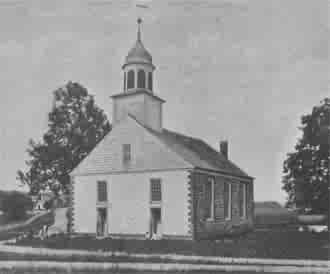
simple yet sturdy construction having two doors. (one for men
and one for women!) was faced on the east side with stone and
had a belfry with a weather vane. Stained glass windows were
added in the 1880’s. Situated at the junction of the Valley
Road and the Paterson (or Slooterdam road)[Long Hill Road]
sometimes also referred to as the “Road to Preakness” the church
had been built in 1828, finally replacing the ancient 1740 stone
hexagonal house of worship across the road and an even earlier
1710 log cabin church called “Church de’ Nor’” by the Dutch.
It survived until 1935 when it was razed and a small “Chapel” built
closer to what became the “town center”. The Oakland Library,
former “Community building” was built to replicate it. When later
renovated in the 1880’s the double doors were dispensed with and
a single entry door replaced the old Dutch style.

